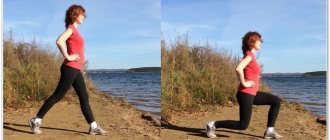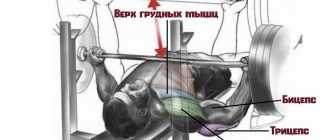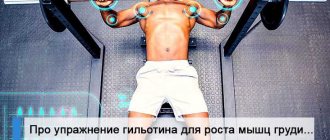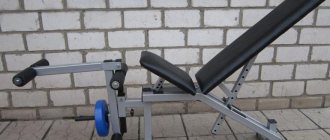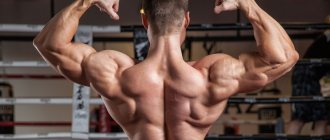Author: Timko Ilya - the ruler of the entire site and fitness trainer | more details >> Rod. 1984 Trained since 1999 Trained since 2007. Author and creator of the site tvoytrener.com. CCM in powerlifting. Champion of Russia and South Russia according to AWPC. Champion of the Krasnodar region according to IPF. 1st category in weightlifting. 2-time winner of the Krasnodar Territory championship in t/a. Author of more than 700 articles on fitness and amateur athletics. Author and co-author of 5 books.
Place in the author rating:
out of competition
(become an author)
Date:
2012-05-29
Views:
171,637
Rating:
5.0
| All articles by the author >> | Medals articles >> |
Articles are loading...
| Article medals: | more than 100 thousand views |
Why medals are given to articles:
| Bronze medal: | |
| 1. The article is in the TOP 100 2. The article has more than 3. The article has more than 100 | |
| Silver medal: | |
| 1. The article is in the TOP 50 2. The article has more than 3. The article has more than 500 | |
| Gold medal: | |
| 1. The article is in the TOP 10 2. The article has more than 1 3. The article has more than 1,000 | |
Primary muscles - external oblique abdominal muscle Additional - internal oblique abdominal muscle Difficulty - easy
Description of the exercise
Not a very effective exercise. Rather suitable for warming up. It is practically useless to do it with a small weight, and dangerous with a large one. Alternatively, you can try bending over.
Main features
1. It is the oblique muscles that create the corset that keeps the waist in good tone.
2. Place your hands on the edges of the stick and look ahead as you move. The amplitude of movement should be maximum. The back is straight. The spine is positioned vertically.
3. The most common mistakes are tilting the body forward or rotating with the head. This performance makes your head spin.
4. Rotation should be performed for 2 - 3 minutes. Minimum 100 repetitions in each direction.
5. Do not rotate with the bar from the barbell. You may injure your back. Take a light gymnastic stick.
6. This exercise can also be done from the top block. The advantage is that you can use weights in this case.
A set of stretching and flexibility exercises
Exercise 1. Side bends
- Stand up straight. Place your feet shoulder-width apart and your hands on your waist.
- Tilt left and right.
- Do the exercise 12 times.
Exercise 2. Circular rotations of the torso
- Feet shoulder width apart. Place your hands on your belt.
- Perform circular rotations with your torso to the right 8 times.
- Repeat the same movement 8 times to the left.
- Don't forget about rhythmic breathing.
Exercise 3. Circular rotations of the pelvis
- Place your feet shoulder-width apart. Hands are behind the head.
- Make circular movements with your pelvis. 8 times one way, 8 times the other.
Exercise 4. Circular rotations with knees
- Feet together, hands on knees.
- Start rotating your knees: 8 times to the right, 8 times to the left.
- Bend only your right leg. Perform rotations 8 times in both directions.
- Bend only your left leg. Rotate left and right 8 times.
Exercise 5. Bends forward
- Place your feet shoulder-width apart.
- Perform 12 springy forward bends.
Exercise 6. Lunges
- First, lunge with one leg to the side.
- Shift your body weight to the bent leg and straighten the other one to the side.
- Move from side to side 12 times.
- Then lunge forward with one leg. Do 8 springy movements and change legs.
Exercise 7. Squats
- Get on your knees.
- Do 12 squats.
Exercise 8. Spread your legs
- Sit on the floor.
- Straighten one leg forward, and bend the other and move it back.
- Bend towards your extended leg.
- Repeat the exercise 12 times.
Exercise 9. Stretching for the lower back and buttocks
- Lie on your back.
- Bend your right leg and bring it towards your chest. Hold for 30-40 seconds.
- Switch legs and do the same steps.
You may feel a slight stretch in your lower back and back of your thighs. This exercise will help you relax.
Rules for men's yoga classes
Many representatives of the stronger sex, who decide to give preference to exercises to strengthen their male health, delve headlong into the sequence of their implementation. However, at the same time, they forget about general recommendations, ignoring which can lead to the lack of the desired result.
- For people who have not done yoga at all before, it is better not to take risks and not start straight away with men's yoga. For such classes it is necessary that the trainee already has a certain amount of knowledge and skills. Thus, it is better to start with regular yoga and then move on to specialized training.
- You should not start performing asanas without first warming up. Otherwise, you may harm your joints and muscles. This risk is especially great for those areas of the body that are most involved during gymnastics (neck or back). Simple bends, as well as rotational movements with elbows and knees, are suitable for warming up.
- You need to approach training wisely, and not be too overzealous with your workouts. It is obvious that each of us wants to achieve results as soon as possible. However, everyone's level of physical fitness and flexibility is individual, and it is impossible to cross it. Don't worry, because with regular exercise, flexibility is developed quite quickly, and the exercises will become easier to perform over time.
- It is recommended to take the last meal before training no later than 1.5 hours.
- The optimal time, when all internal human processes are maximally activated, is considered to be the morning hours. If it doesn't suit you, you can choose any other. The key condition that must be taken into account is that the class should not be held before bedtime, but approximately 2 hours before bedtime.
- You should try to move into each subsequent asana as slowly and smoothly as possible, avoiding abruptness and the use of special efforts.
- During the exercises, you should concentrate not only on the movements themselves, but also on breathing. In addition, it is important to pay special attention to your inner feelings - this will avoid unnecessary discomfort and even possible injury.
- Speaking about the duration of asanas, it is worth noting that everyone determines this time for themselves, based on their personal condition and well-being, because training should be exclusively enjoyable.
- With any movement, you need to keep unused muscles in a relaxed state.
- Even if not everything is successful from the very beginning, you should not rush to finish your training. It will be possible to achieve visible results in the intimate sphere and give the body stamina and flexibility only with systematic exercise.
Results of comparative analysis
The machine torso rotation demonstrated greater muscle activity in the left external oblique compared to the torso rotation performed with elastic resistance, whereas the elastic exercise demonstrated greater activation of the right erector dorsi muscle. The effects of both versions of the torso rotation were quite similar. No significant differences were found for the rectus abdominis, right external oblique and left erector muscles of the back. Rotation of the trunk in a standing position appears to increase muscle activity of the posterior extensors, potentially as a means of maintaining balance and stability. However, it is likely that the increased support on the erectors of the back in the standing position is specific to exercise. For example, in a study by Saeterbakken and Fimland [1], there were no differences in erector spinal muscle activity when comparing seated and standing dumbbell presses.
When the researchers asked participants which exercise they preferred more of the two, 76% preferred the resistance torso crunch over the machine exercise. Perceived load was not significantly different between mechanical and elastic load.
Brief and to the point
If we put all the advice together, then:
- Avoid overhead presses and overhead rows;
- do not use a Smith machine (with some exceptions);
- do not position your hands too narrowly when doing barbell rows and triceps presses;
- do not rotate your body with weights on your shoulders;
- do not jump with a barbell on your shoulders.
Without strength, there will be neither speed, nor sharpness of blows, nor special endurance, which allows maintaining a high density of combat actions during the battle, light and fast movements around the ring to forcefully counter the enemy in close combat.
In the various actions of boxers, the main work is performed by the deltoid and extensor muscles of the arms, the pectoral and oblique muscles of the abdomen, back and legs.
These muscles also develop during regular training, but in order to meet modern strength training requirements, a boxer must systematically use special exercises with weights.
Some may think that boxing is enough to keep themselves in optimal physical shape. This is not entirely true. Despite the fact that boxing harmoniously develops and trains a lot of muscle groups, it is believed that through strength training athletes have the opportunity to improve their performance. Any movement a person makes is the result of muscle contraction. By increasing the size of the functional unit of muscle tissue (myofibrillar hypertrophy), you will increase the speed and power of movements.
But increasing muscle mass is not such an easy task, otherwise every gym goer would look like Arnold Schwarzenegger. In addition to good genetics, in order to achieve a high level of muscularity and massiveness, it is necessary to regularly engage in strength training, gradually increasing it.
Leading trainers note that in the training process of a boxer, the use of such means of general physical training as running plays an important role, and it is better if it is not a treadmill in the gym, but cross-country running, sports games (football, volleyball, basketball, etc.) .), aimed at developing endurance, agility and speed.
In addition, you need to pay special attention to the development of the leg muscles involved in repulsion and extension when moving around the ring.
Recommendations from Honored Trainers of Russia A.I. Garakyan, O.V. Menshikov, Z.M. Khusyainova: “Exercises with a barbell on the shoulders, half-squats and stretches are useful for developing the muscles of the torso - turning the body left and right with the bar on the shoulders and rotating the torso with arms spread to the sides with dumbbells. To develop arm muscles (one end of the bar is clamped in the hand, the other is fixed to the floor) - strikes with weights. We have developed a method of training boxers that combines elements of general and special physical training at the general preparatory stage.
exercise 1. Step-up exercise with a barbell on the shoulders.
The weight of the barbell is 70 percent of the athlete’s own weight. Exercises are performed in series of 5 to 6 with 10-12 repetitions in each series. During exercises, the shoulders are pulled back, the hands press the bar
Exercise 2. Torso rotations with the bar on the shoulders.
Bar weight 15-20 kg. The exercise is performed at an average pace, with the hands pressing the bar to the shoulders. In this case, special attention is paid to the work of the legs and the position of the bar (strictly vertical in relation to the starting position). The exercise is performed in series of 5 to 6, 20 repetitions in each series. Rest between series is 1-2 minutes, which is filled with side blows. Exercise 3. Push the vertical bar with the left and right hand, simulating a direct blow. Bar weight 15-20 kg. The exercises are performed at an average pace, taking into account the correct coordination of direct strikes. During the workout, 5-6 series of 20 repetitions are performed with each hand. Rest pauses of 1-2 minutes are filled with direct strikes at a high tempo. The duration of such a workout is from 60 to 80 minutes."
The training program for boxers, unlike bodybuilders, is characterized by an emphasis not on great achievements in gaining muscle mass, but on training the nervous system and hypertrophy training, increasing flexibility. When you hit a heavy bag, run, or jump rope, you are working on muscular endurance and coordination. But when you step into the gym, it's time to flip the switch. The goal of training in the gym is to develop absolute strength using heavy weights and increase speed-strength qualities by moving medium weights at high speed. The most important thing when working to increase absolute strength and speed-strength qualities is the stimulation of fast-twitch muscle fibers.
However, with all your passion for the art of boxing, do not forget that any physical activity should be PLEASANT to the body, no matter how flat it may sound. It's about the pleasure of playing sports, the joy of knowing that your body has worked hard in training, and not worked to the limit like an old nag. Spare your body, but be strict and attentive to it.
- Take a gymnastic stick in your hands, place it behind your head on your shoulders, grab it with a grip wider than your shoulders - the wider the better, you can grab the very edges.
- Straighten up, bring your shoulder blades together, pushing your chest forward, bend your lower back slightly - let your spine take its natural position. Then the exercise will affect not only your muscles, but also your posture.
- Perform body turns to the right and left due to the efforts of the lateral abdominal muscles to the widest possible amplitude.
This is what it looks like:
Raising the torso
This exercise can affect your body differently depending on the execution, number of repetitions, and weights used. With full lifts, all muscles are involved. Full lifts of the torso have a large amplitude, which increases muscle work.
Technique:
- Sit on a mat, preferably a soft surface for ease of execution, bend your legs at an angle of approximately 90 degrees. This position helps transfer the load to the abdominal muscles and removes it from the spine.
- Secure your feet by placing them under any surface, for example, under the lower bar. You can also use two dumbbells for this purpose, or simply ask another person to hold you. If you perform the exercise at home, a sofa is ideal.
- The starting position has been accepted, it’s time to start the exercise. The head and shoulders should rise first, followed by the rest of the body. Raising a straight body is incorrect. This exercise should resemble a crunch. After your torso has reached a vertical position, return to the starting position without placing your head on the floor. It is best to keep your hands behind your neck. Exhale while lifting.
- It is important to ensure that it is the abdominal muscles that do the work. Don't try to help yourself with other parts of your body. This will only reduce efficiency. If the execution is too difficult for you, you can hold your hands in front of your chest. And if you want to complicate the exercise, you can take weights, for example, a pancake.
Also very popular are partial lifts of the body from a lying position. They can be performed by people of any level of physical fitness. Such lifts of the body differ from full ones in that they work the rectus abdominis muscles. The technique for performing this exercise is very similar to full body raises. The starting position is exactly the same, hold your hands the same way. You just need to lift only the upper part, barely lifting the shoulder blades, and then return to the starting position.
